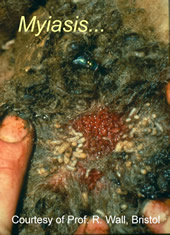You are here
Blowflies
 Information and images relating to these topics is covered in a new on-line talk, as part of the Henry Stewart series on Vector-borne Diseases.
Information and images relating to these topics is covered in a new on-line talk, as part of the Henry Stewart series on Vector-borne Diseases.
See: Stevens, J. (2010), "Myiasis in humans and other animals, including applied applications in larval therapy & forensic entomology", in Edman, J. (ed.), Vector-Borne Diseases, The Biomedical & Life Sciences Collection, Henry Stewart Talks Ltd, London (online at HSTalks.com).
The evolution of ectoparasitism in Calliphoridae (blowflies and screworm flies)
Blowflies are characterized by the ability of their larvae to develop in the flesh living or dead of vertebrates; such parasitism of living animals by dipterous larvae is known as myiasis. The evolutionary origins of the myiasis habit in the Calliphoridae remain unclear. Species associated with an ectoparasitic lifestyle can be divided into three groups based on their larval feeding habits: saprophagous, facultative ectoparasitism, and primary obligate parasitism. Phylogenetic analysis of the 28S rRNA gene and mtDNA cytochrome oxidase subunits I and II sequences are being undertaken to elucidate the origins of the myiasis habit within family Calliphoridae.
Population-level variation in the blowflies, Lucilia sericata and Lucilia cuprina
Genetic variation has been studied at the population level in the cosmopolitan blowfly pests Lucilia sericata and Lucilia cuprina using DNA sequencing, RAPD and RFLP analyses, in combination with classical morphological taxonomic methods. Samples have been obtained from all major sheep rearing areas worldwide. Results have allowed an improved understanding of the genetics and taxonomy of the genus, and the evolution of myiasis (blowfly strike) in Lucilia.
The group has previously contributed to an IAEA research programme: Enabling Technologies for the Expansion of SIT for Old and New World Screwworm Fly, in which the population genetic variation of screwworm flies has been studied with a view to understanding the possible genetic basis of differential efficacy of sterile insect releases.
Researching improved technologies for larval therapy
Through a University of Exeter spin-out company, MediLarv - under the umbrella of BioElf, we are engaged in researching the biological basis of larval therapy, a technique which, though now relatively fashionable again in mainstream medicine, is little different today from when first practised on the battlefields of the American Civil War. Our research is directed towards understanding the biochemical basis of the healing action of the larvae, with the eventual aim of removing altogether the maggots from the process, i.e. taking the maggot out of the equation; see related BBC News article.
Publications
Evolution of myiasis
- Stevens, J. & Wall, R. (1996) Classification of the genus Lucilia (Diptera: Calliphoridae): a preliminary parsimony analysis. Journal of Natural History 30: 1087-1094. [View PDF]
- Stevens, J. & Wall, R. (1997) The evolution of ectoparasitism in the genus Lucilia (Diptera: Calliphoridae). International Journal for Parasitology 27: 51-59. [View PDF]
- Otranto, D. & Stevens, J. R. (2002) Molecular approaches to the study of myiasis-causing larvae. International Journal for Parasitology, 32: 1345-1360. [View PDF]
- Stevens, J.R. (2003) The evolution of myiasis in blowflies (Calliphoridae). International Journal for Parasitology, 33: (10) 1105-1113. [View PDF]
- Stevens, J.R. & Wallman, J.F. (2006) The evolution of myiasis in humans and other animals in the Old and New Worlds (part I): phylogenetic analyses. Trends in Parasitology, 22 (3): 129-136. [View PDF]
- Stevens, J.R., Wallman, J.F., Otranto, D., Wall, R. & Pape, T. (2006) The evolution of myiasis in humans and other animals in the Old and New Worlds (part II): biological and life-history studies. Trends in Parasitology, 22 (4): 181-188. [View PDF]
- McDonagh, L.M. & Stevens, J.R. (2011) The molecular systematics of blowflies and screwworm flies (Diptera: Calliphoridae) using 28S rRNA, COX1 and EF-1α: insights into the evolution of dipteran parasitism. Parasitology, 138: 1760–1777. [View PDF]
- Morgan, E.R., Clare, E.L., Jefferies, R. & Stevens, J.R. (2012) Parasite epidemiology in a changing world: can molecular phylogeography help us tell the wood from the trees? Parasitology [View PDF]
- Arias-Robledo, G., Stark, T., Wall, R.L. & Stevens, J.R. (2018) The toad fly Lucilia bufonivora: its evolutionary status and molecular identification. Medical and Veterinary Entomology, in press, doi: 10.1111/mve.12328 [View PDF]
GB Wildlife Disease Surveillance Partnership quarterly report: Disease surveillance and emerging threats. Volume 23, Oct–Dec 2018 [download toad fly factsheet].
- 25700 reads
The University of Exeter, The Queen's Drive, Exeter, Devon, UK EX4 4QJ
Copyright and Disclaimer

